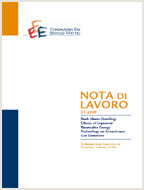Carbon Kuznets Curves: Long-run Structural Dynamics and Policy Events

30.08.2009
Massimiliano Mazzanti, Antonio Musolesi
C23, Q53
Carbon Kuznets Curve, Panel Cointegration, Heterogeneous Panels, Cross-Section Correlation, Kyoto Framework, Bayesian Models, Policy Events, Long Run Dynamics
Climate Change and Sustainable Development
Carlo Carraro
We study the structural differences among climate change leading ‘factors’ – Northern EU members -, and lagging actors – southern EU countries and the ‘Umbrella group’ – with regard to long run carbon-income relationships. Homogeneous and heterogeneous panel models show that the groups of countries less in favour of stringent climate policy have yet to experience a Kuznets curve, though they show relative delinking. Northern EU instead robustly shows bell shapes. Exogenous policy events such as the 1992 climate change convention appear to be relevant in shaping the EKC of Northern EU. In addition, other events such as the second oil price shock appear to have also impacted in shaping the long run emission/GDP dynamics.
